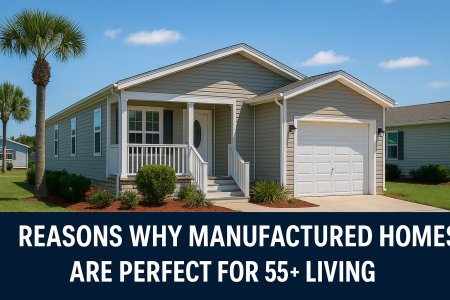Retirement—and the years leading up to it—should be a season of freedom, simplicity, and intentional living. For many adults over 55, choosing the right home becomes the anchor for that next chapter. While site-built houses get most of the attention, manufactured homes have quietly become a modern, practical, and inspiring alternative.
Importantly, the U.S. Department of Housing and Urban Development (HUD) requires manufactured homes to meet strict national safety, durability, and energy standards. Consequently, today’s models deliver the comfort, efficiency, and style many retirees want—without the sticker shock.
1) Affordability Without Compromise
Budgeting takes center stage in retirement planning. Manufactured homes consistently cost less per square foot than comparable site-built homes, allowing you to stretch savings further and redirect funds toward travel, hobbies, healthcare, or helping family. Lower upfront costs also mean fewer financial trade-offs and less pressure to liquidate investments prematurely.
Even better, affordability doesn’t mean settling. Modern floor plans boast open kitchens, quality cabinetry, resilient flooring, and thoughtful storage. Many communities also negotiate bulk utility rates or include services that keep monthly costs predictable—another win for fixed-income households.
2) Downsizing With Dignity
After decades of maintaining larger homes, many 55-plus adults prefer right-sized living. Manufactured homes make it easy to downsize without feeling cramped. You can choose practical two-bedroom designs, integrated flex rooms, and wide, accessible hallways that make everyday living simple and safe.
Moreover, less square footage means less to clean, repair, heat, and cool. As a result, you reclaim time and energy for fitness, volunteering, travel, and family—activities that enrich this phase of life far more than managing unused rooms ever could.
3) Energy Efficiency That Benefits Your Wallet
Homes built under the HUD Code (effective since 1976 and updated over time) incorporate strong baseline standards for performance, including energy measures. Many models feature double-pane windows, upgraded insulation, tight ductwork, and high-efficiency systems. When combined with ENERGY STAR® appliances, the result is lower utility bills month after month.
If you live in warmer climates, you’ll also find designs optimized for heat and humidity control—reflective roof materials, covered entries, and ventilation strategies that maintain comfort while minimizing HVAC strain. Over the long run, these features preserve your budget and increase daily comfort.
4) Community-Centered Living
Manufactured home communities designed for residents 55 and over foster connection and convenience. Expect amenities like clubhouses, pools, fitness rooms, pickleball courts, dog parks, workshops, and walking paths. Regular social calendars—potlucks, classes, day trips—make it easy to meet neighbors and build friendships.
Equally important, living among peers offers a built-in support network. Need a recommendation for a specialist, a ride to an appointment, or a walking buddy? In these communities, help is often just a door—or a group text—away.
5) Low-Maintenance Lifestyle
Traditional homeownership can mean endless chores—roofing issues, exterior painting, tree trimming, and more. By contrast, many manufactured home communities include landscaping and exterior upkeep in a modest monthly fee, or they offer vetted vendors who provide quick, fairly priced service.
Therefore, weekends stop being a to-do list. Instead, you gain a dependable routine and a cleaner, calmer calendar. That’s a significant quality-of-life advantage—especially if you travel seasonally or split time between states.
6) Safety, Security, and Peace of Mind
Safety ranks high for 55+ buyers, and rightly so. Modern manufactured homes are engineered to rigorous national standards for structural integrity, fire safety, and weather resistance, overseen by HUD’s Manufactured Housing Program. Many communities are also gated and maintain neighborhood watch or security patrols.
Inside the home, single-level designs minimize trip hazards, and many floor plans can incorporate no-threshold showers, grab bars, lever handles, and wider doorways. These features support aging in place gracefully and independently.
7) Prime Locations for Retirement Living
Manufactured home communities often cluster in retirement-friendly regions with mild winters, abundant healthcare, and plentiful recreation—think Florida coasts, Arizona valleys, or the Carolinas. As a result, you can live where others vacation, close to beaches, golf, nature preserves, and cultural attractions.
Proximity matters. Being near airports, major hospitals, and shopping keeps daily life convenient while making visits from family and friends simpler and more frequent.
8) Financial Flexibility and Equity Options
Unlike renting, purchasing a manufactured home allows you to build equity. Furthermore, because prices are typically lower than site-built homes, buyers can often avoid large mortgages or even purchase outright—reducing risk and preserving cash flow.
You can also choose between placing a home on owned land or in a land-lease community. Each path has pros and cons, but the choice itself offers strategic flexibility: prioritize lower upfront costs, or emphasize long-term appreciation and control.
9) A Modern, Customizable Lifestyle
Today’s manufactured homes defy outdated stereotypes. Buyers routinely select finishes, fixtures, and layouts—including kitchen islands, walk-in pantries, spa-style baths, and covered outdoor living. With thoughtful design, these homes look and live like upscale cottages.
Because many communities are 55-plus by design, they also plan for accessibility and convenience from day one. Add screened lanais, hobby sheds, EV-ready parking, or smart-home tech to tailor your space precisely to how you live now—and how you’ll live five or ten years from now.
Conclusion: A Lifestyle Designed for You
Manufactured homes have become a cornerstone of smart, stress-free retirement living. They combine affordability, efficiency, and community in a way that supports how 55-plus adults actually want to live—comfortably, socially, and on their terms.
As national standards continue to evolve under HUD oversight and communities expand, opportunities will only grow. If you’re seeking more freedom with fewer hassles, consider touring a 55-plus manufactured home community. You may discover the home—and lifestyle—you’ve been working toward all along.
